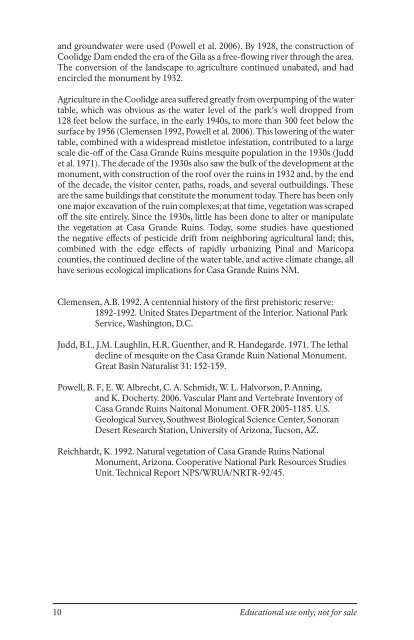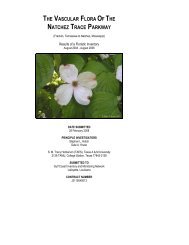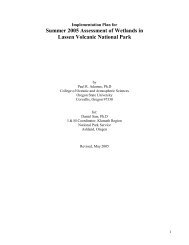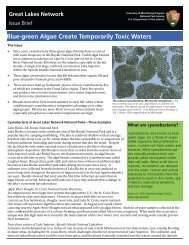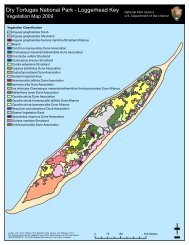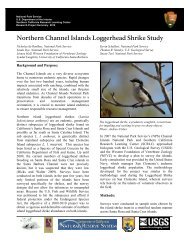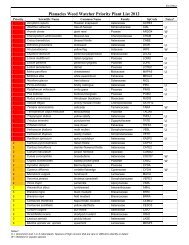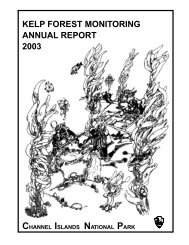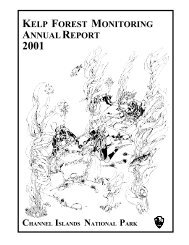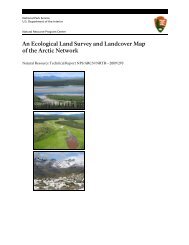Plants of Casa Grande Ruins National Monument - NPS Inventory ...
Plants of Casa Grande Ruins National Monument - NPS Inventory ...
Plants of Casa Grande Ruins National Monument - NPS Inventory ...
You also want an ePaper? Increase the reach of your titles
YUMPU automatically turns print PDFs into web optimized ePapers that Google loves.
and groundwater were used (Powell et al. 2006). By 1928, the construction <strong>of</strong><br />
Coolidge Dam ended the era <strong>of</strong> the Gila as a free-flowing river through the area.<br />
The conversion <strong>of</strong> the landscape to agriculture continued unabated, and had<br />
encircled the monument by 1932.<br />
Agriculture in the Coolidge area suffered greatly from overpumping <strong>of</strong> the water<br />
table, which was obvious as the water level <strong>of</strong> the park’s well dropped from<br />
128 feet below the surface, in the early 1940s, to more than 300 feet below the<br />
surface by 1956 (Clemensen 1992, Powell et al. 2006). This lowering <strong>of</strong> the water<br />
table, combined with a widespread mistletoe infestation, contributed to a large<br />
scale die-<strong>of</strong>f <strong>of</strong> the <strong>Casa</strong> <strong>Grande</strong> <strong>Ruins</strong> mesquite population in the 1930s (Judd<br />
et al. 1971). The decade <strong>of</strong> the 1930s also saw the bulk <strong>of</strong> the development at the<br />
monument, with construction <strong>of</strong> the ro<strong>of</strong> over the ruins in 1932 and, by the end<br />
<strong>of</strong> the decade, the visitor center, paths, roads, and several outbuildings. These<br />
are the same buildings that constitute the monument today. There has been only<br />
one major excavation <strong>of</strong> the ruin complexes; at that time, vegetation was scraped<br />
<strong>of</strong>f the site entirely. Since the 1930s, little has been done to alter or manipulate<br />
the vegetation at <strong>Casa</strong> <strong>Grande</strong> <strong>Ruins</strong>. Today, some studies have questioned<br />
the negative effects <strong>of</strong> pesticide drift from neighboring agricultural land; this,<br />
combined with the edge effects <strong>of</strong> rapidly urbanizing Pinal and Maricopa<br />
counties, the continued decline <strong>of</strong> the water table, and active climate change, all<br />
have serious ecological implications for <strong>Casa</strong> <strong>Grande</strong> <strong>Ruins</strong> NM.<br />
Clemensen, A.B. 1992. A centennial history <strong>of</strong> the first prehistoric reserve:<br />
1892-1992. United States Department <strong>of</strong> the Interior. <strong>National</strong> Park<br />
Service, Washington, D.C.<br />
Judd, B.I., J.M. Laughlin, H.R. Guenther, and R. Handegarde. 1971. The lethal<br />
decline <strong>of</strong> mesquite on the <strong>Casa</strong> <strong>Grande</strong> Ruin <strong>National</strong> <strong>Monument</strong>.<br />
Great Basin Naturalist 31: 152-159.<br />
Powell, B. F, E. W. Albrecht, C. A. Schmidt, W. L. Halvorson, P. Anning,<br />
and K. Docherty. 2006. Vascular Plant and Vertebrate <strong>Inventory</strong> <strong>of</strong><br />
<strong>Casa</strong> <strong>Grande</strong> <strong>Ruins</strong> Naitonal <strong>Monument</strong>. OFR 2005-1185. U.S.<br />
Geological Survey, Southwest Biological Science Center, Sonoran<br />
Desert Research Station, University <strong>of</strong> Arizona, Tucson, AZ.<br />
Reichhardt, K. 1992. Natural vegetation <strong>of</strong> <strong>Casa</strong> <strong>Grande</strong> <strong>Ruins</strong> <strong>National</strong><br />
<strong>Monument</strong>, Arizona. Cooperative <strong>National</strong> Park Resources Studies<br />
Unit. Technical Report <strong>NPS</strong>/WRUA/NRTR-92/45.<br />
10 Educational use only; not for sale


